The “fake news” phenomenon has diminished many Americans’ trust in the news, particularly undermining our perceptions of content produced by online media brands, much of which for years had already been criticized for being poorly researched and lacking the copy editing and fact-checking protocols long considered linchpins at our print media mainstays.
As we’ve learned from the recent Russian investigations, an increasing amount of this content is also downright duplicitous, highlighting not only the real, palpable damage fake news can cause but also its readers’ credulity, an increasing number of whom apparently lack the critical thinking skills necessary to parse truth from fiction.
Now, magazine industry trade group The Association of Magazine Media is combatting the fake news problem by kicking off a new industry-wide advertising campaign in a bid to remind consumers that magazines offer credible content and quality journalism in a media environment increasingly bereft of those qualities.
The campaign, titled “Magazine Media. Better. Believe It.” began this month and brings together 30 MPA member media brands representing more than 120 major magazine titles that have each agreed to lend print and digital ad space to the effort.
“With fake news leaving most Americans confused about even the basic facts, magazine media keeps it real,” reads one of the campaign’s recent ad placements. “Whether in print, online, on mobile or video, people trust it to be expertly researched, written and fact-checked. No wonder magazine readers are more engaged and more likely to recommend advertised products.”
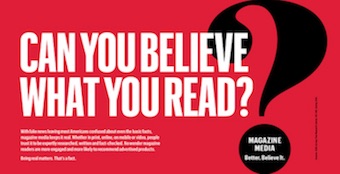 |
Some of the companies participating in the campaign include Condé Nast, Hearst Magazines, Forbes, Harper’s, National Geographic, Time Inc. and Trusted Media Brands.
“In a media world where three out of four Americans say they have fallen for fake headlines, it is imperative to remind audiences of the tremendous resources that the magazine media industry puts behind its content platforms,” wrote MPA president and CEO Linda Thomas Brooks in an October LinkedIn post announcing the campaign’s launch. “Magazine media content faces intense scrutiny, and in large part that is the secret sauce of these brands. By imposing extreme rigor, discipline and standards upon content creation, magazine brands do a better job of putting information in context and deliver a level of superior quality that readers have come to expect and trust in their everyday lives.”
An August report published by the Reynolds Journalism Institute at the University of Missouri found that web-based news outlets account for the least trusted media brands in America, regardless of whether those outlets lean left or right.
The report found that UK-based weekly magazine The Economist was considered the most trusted news source among Americans today. British daily newspaper The Guardian, News Corp.-owned Wall Street Journal, the Los Angeles Times and the Dallas Morning News were other print outlets that filled out the Reynolds Journalism Institute’s top 10 most trusted news organizations.
By contrast, every single one of the news sources ranked as least trusted among Americans — Occupy Democrats, BuzzFeed, Infowars, Yahoo, Huffington Post and The Blaze — belonged to a digital publisher.


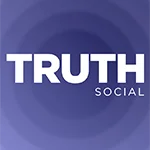 Trump Media & Technology Group today reported a $58.2M net loss on $4.1M in 2023 revenues, a disclosure that drove its stock price down 22.6 percent to $47.96.
Trump Media & Technology Group today reported a $58.2M net loss on $4.1M in 2023 revenues, a disclosure that drove its stock price down 22.6 percent to $47.96. Barry Pollack, an attorney at Wall Street’s Harris St. Laurent & Wechsler, has registered Julian Assange as a client with the Justice Dept. “out of an abundance of caution.”
Barry Pollack, an attorney at Wall Street’s Harris St. Laurent & Wechsler, has registered Julian Assange as a client with the Justice Dept. “out of an abundance of caution.”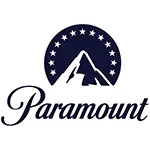 Paramount Global to slash 800 jobs in what chief executive Bob Bakish calls part of an effort to “return the company to earnings growth"... Rolling Stone editor-in-chief Noah Shachtman is exiting at the end of the month due to disagreements with chief executive Gus Wenner over the direction the magazine is taking... The New York Times broke the $1 billion barrier in annual revenue from digital subscriptions in 2023... Press Forward is investing more than $500 million to strengthen local newsrooms.
Paramount Global to slash 800 jobs in what chief executive Bob Bakish calls part of an effort to “return the company to earnings growth"... Rolling Stone editor-in-chief Noah Shachtman is exiting at the end of the month due to disagreements with chief executive Gus Wenner over the direction the magazine is taking... The New York Times broke the $1 billion barrier in annual revenue from digital subscriptions in 2023... Press Forward is investing more than $500 million to strengthen local newsrooms.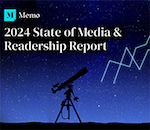 The majority of news articles are read within the first three days of publication, according to a recent report.
The majority of news articles are read within the first three days of publication, according to a recent report.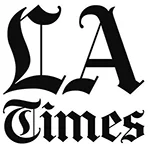 The Los Angeles Times gives pink slips to 115 people or 20 percent of its newsroom staff... TIME is also laying off about 30 employees, which is approximately 15 percent of its editorial staff... The Baltimore Banner, which was launched by Stewart Bainum in 2022 after he failed to buy the Baltimore Sun, added 500 subscribers per day in the three days following Sinclair Broadcast Group's deal to purchase the Sun.
The Los Angeles Times gives pink slips to 115 people or 20 percent of its newsroom staff... TIME is also laying off about 30 employees, which is approximately 15 percent of its editorial staff... The Baltimore Banner, which was launched by Stewart Bainum in 2022 after he failed to buy the Baltimore Sun, added 500 subscribers per day in the three days following Sinclair Broadcast Group's deal to purchase the Sun.


 Have a comment? Send it to
Have a comment? Send it to 
No comments have been submitted for this story yet.